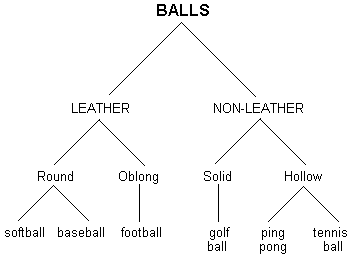
ANTH 130 Introduction to Archaeology
Dr. Darlene Applegate
Fall 2007
Answers to Exam 2 Practice Questions

1. Which of the following statements about archaeological research
design
is false?
a. Artifact location is the fifth step.
b. Artifact recovery is the sixth step.
c. Archaeological classification and dating are part of the seventh step.
d. Whereas location and recovery are accomplished in the field, classification and dating usually occur in the lab.
e. The first step of archaeological research design - asking a research question - has little influence on the processes of artifact location, artifact recovery, classification, and dating.
2. Flotation is intended to recover which type of artifact?
a. charcoal
b. flakes
c. pottery sherds
d. nails
e. projectile points
3. In the following hierarchy, what attribute was used at the first
division?

a. function
b. raw material / composition
c. age
d. color
e. shape
4. Which of the following is not a goal of archaeological
classification?
a. explain differences in artifacts from different sites
b. identify artifact types
c. identify relationships among artifact types
d. make archaeological collections more manageable
e. separate artifacts according to density
5. Which of the following statements about classification is false?
a. Hierarchies only use two attributes to classify artifacts.
b. Paradigms produce a tabular (table) classification scheme.
c. Hierarchies are more flexible than paradigms.
d. Hierarchies are hierarchically-arranged levels of related artifact types.
e. None of these is false.
6. The field methods used by an
archaeologist
depends on all of the following factors except
7. True or False: A
tradition
is a collection of traits that have broad geographic distribution but
limited
temporal range, while a phase is a collection of traits that have
limited
geographic distribution but wide temporal range. switched
8. True or False: Sites
are
typically classified according to cultural affiliation, temporal
affiliation,
geographic location, and function.
9. True or False:
Composition,
function, age, species, and modification are attributes commonly used
in
classifying artifacts.
10. True or False: Three
dimensions
of variation of concern to archaeologists are time, space and form.
11. True or
False:
Flotation is a method used by archaeologists to recover small organic
artifacts
from archaeological sediments.
12. True or
False:
Shadow marks, soil marks, and crop marks on aerial photographs can be
used
to both locate and recover archaeological information.
13. Excavation is an example of a/an invasive
recovery technique.
14. Materials that float to the surface of a flotation sample are
called
the light
fraction,
while materials that do not float to the surface of a flotation sample
are called the heavy
fraction.
15. The figure below shows an example of a/an paradigmatic
classification.
| MOBILE | SEDENTARY | |
| SMALL | gathering camp | village |
| MEDIUM | base camp | town |
| LARGE | settlement | city |
16. In the figure above, the two attributes used to classify sites
are
size
and permanence
.